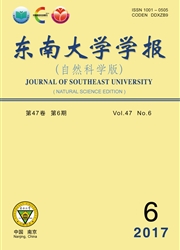

 中文摘要:
中文摘要:
基于人工神经网络方法建立了RFID反射信号强度分布模型.该方法仅依赖数据,实施简单.为克服传统BP算法对初值敏感、易陷入局部极值的缺陷,引入一种连续的蚁群优化算法来确定多层神经网络的权值,该算法具有更强的全局搜索能力和效率.讨论了算法的基本理论和具体步骤,最后利用实际RFID设备采集的反射信号强度数据对算法进行测试,对理论信号模型和实际的建模结果进行了比较,并分析了算法的逼近能力和泛化能力.结果表明在考虑到不可避免的误差和扰动下,所提出的方法可以更好地建模RFID信号强度的实际分布,具有良好的性能.
 英文摘要:
英文摘要:
A radio frequency identification(RFID) reflected signal strength distribution model is built based on the artificial neural netw ork method.This method only depends on data and it can be easily implemented.To overcome the shortcomings of the traditional back-propagation(BP) algorithm,w hich is sensitive to initial value and is easy to trap into local optima,a continuous ant colony optimization algorithm is introduced to determine the w eights of multilayer neural netw orks.This algorithm has a stronger global searching ability and efficiency.The basic theory and the concrete steps of the algorithm are discussed.Finally,the algorithm is tested using the reflected signal strength data collected from actual RFID device.The theoretical signal strength model and the actual modeling result are compared.And the approximation ability and generalization ability of the algorithm are also analyzed.The results show that in consideration of the inevitable errors and disturbances,the proposed method can better model the actual RFID signal strength distribution and has good performance.
 同期刊论文项目
同期刊论文项目
 同项目期刊论文
同项目期刊论文
 Graphical design for stability of linear active disturbance rejection control to first order time de
Graphical design for stability of linear active disturbance rejection control to first order time de Projective synchronisation of fractional- order memristive systems with different structures based o
Projective synchronisation of fractional- order memristive systems with different structures based o Discrete non-linear adaptive data driven control based upon simultaneous perturbation stochastic app
Discrete non-linear adaptive data driven control based upon simultaneous perturbation stochastic app Leader-following formation control for second-order multiagent systems with time-varying delay and n
Leader-following formation control for second-order multiagent systems with time-varying delay and n PID Pitch Attitude Control for Unstable Flight Vehicle in the Presence of Actuator Delay: Tuning and
PID Pitch Attitude Control for Unstable Flight Vehicle in the Presence of Actuator Delay: Tuning and Neural-networks-based distributed output regulation of multi-agent systems with nonlinear dynamics s
Neural-networks-based distributed output regulation of multi-agent systems with nonlinear dynamics s Leader-following Consensus of Second-order Time-delay Multi-agent Systems with and without Nonlinear
Leader-following Consensus of Second-order Time-delay Multi-agent Systems with and without Nonlinear Semi-tensor product of matrices approach to reachability of finite automata with application to lang
Semi-tensor product of matrices approach to reachability of finite automata with application to lang Analytical and numerical investigation of a new Lorenz-like chaotic attractor with compound structur
Analytical and numerical investigation of a new Lorenz-like chaotic attractor with compound structur Distributed robustconsensus control for nonlinear multi-agent systems by using output regulationappr
Distributed robustconsensus control for nonlinear multi-agent systems by using output regulationappr Modeling RFID signal distribution based on neural network combined with continuous ant colony optimi
Modeling RFID signal distribution based on neural network combined with continuous ant colony optimi 期刊信息
期刊信息
